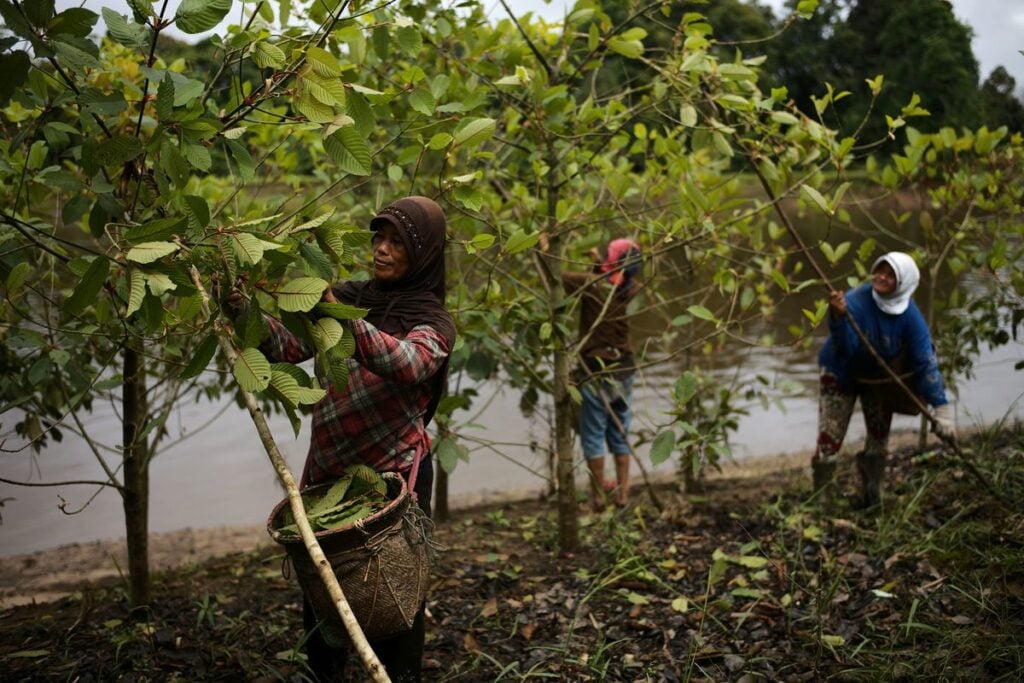If you’re a Kratom fan who has been enjoying it for some time, you might be wondering exactly how the Kratom that you love comes to be.
Some people know that Kratom powders and leaves are simply dried leaves from the Kratom tree, but what exactly happens to get those leaves off the trees and to you? Does it take a long time for these leaves to be harvested and shipped to stores around the world?
Today, we’re going to take a closer look at the Kratom harvesting process. How are the leaves harvested, and what happens to the leaves before they make it to your hands? Let’s find out together.
First: The Kratom Tree
The first thing that you need to know about is the Kratom tree itself. Many people do not realize that Kratom comes from an evergreen tree, and the tree is a remarkable specimen that can soar to heights over 70 feet when in the right conditions.
The Kratom tree is native to humid tropical environments where the soil is fertile and the air is moist. Kratom’s scientific name is Mitragyna speciosa, and the tree has green leaves that have a glossy, waxy appearance.
Since Kratom is an evergreen tree, the leaves are there year-round. The leaves do fall during some cycles of growth when mature, but the tree is never completely barren. The Kratom tree can be found natively in Malaysia, Indonesia, and other regions of Southeast Asia.
As the Kratom tree doesn’t grow well in other regions, most of the world’s supply of Kratom comes from these areas.
Next: The Harvest
There is a lot of variation within Kratom leaves. Depending on how the tree was growing, the soil type, and many other factors, you may see variation in the size, coloration, and chemical composition of the leaves. Color is a particularly interesting part of the harvesting process, as the color varies not only because of how it grows but also because of how it is processed.
Farmers pick Kratom leaves, and this process is done very carefully so that the tree can continue to grow leaves. Farmers monitor the leaves to choose the leaves in the right stage of maturity and growth for the harvest.
Depending on what type of final Kratom product they are aiming for, the leaves will be harvested at different times. The time of harvest has a big effect on the leaves’ chemical composition, which is why the harvest time is so important to farmers. Experienced farmers know exactly how to monitor their leaves and harvest the right leaves at the right time.
Now: Drying and Processing
Once the leaves are picked, they need to be dried in order to be able to be processed and packaged. However, not all leaves are dried in the same way. As mentioned above, the drying process is somewhat responsible for the color and strain type of the leaves, so farmers also have to determine how they are going to dry the leaves.
Kratom leaves are spread or hung on large racks. These racks are then either placed inside to dry, outside to dry, or moved through a combination of both.
How the leaves dry affects the alkaloid composition of the final dried leaves. As you might know, the alkaloids in Kratom are responsible for Kratom’s effects. Different percentages of different alkaloids lead to different strains of kratom, so the drying process is very important. Sunlight plays a big factor in how powerful the alkaloids in the final leaf product are.
Once the leaves are dried, some farmers will put the leaves through additional processes such as extra-long UV exposure periods or fermenting. These processes further alter the alkaloid makeup of the Kratom, and the variety of processing techniques is why there are so many strains of Kratom out there.
Last: Blending and Packaging
Vendors like us buy Kratom from farmers who have harvested and dried different strains. Some of those strains are sold directly as they are received; others are further blended into unique proprietary mixes.
As you probably know, you can buy Kratom leaf, powders, capsules, and a number of other Kratom products. Blending and processing Kratom supplements into other forms adds some variety to what is on the market for customers like you.
If you have only ever tried one type of Kratom, there are more out there for you to explore! Remember that every step of the harvesting process has many different variations. What are you waiting for? There are lots of alternatives.
Buying From Reliable Vendors
As you can see throughout the Kratom harvesting, processing, and packaging process, there are many opportunities for things to go wrong. If Kratom is not treated the right way or if unsafe products are used to process Kratom, this could lead to a not so great final product.
That is why it is so important for you to make sure that you are buying from reliable vendors. High-quality vendors take the time to ensure they are following the latest safety practices. Vendors that work with farmers closely to ensure the Kratom is safely harvested and packaged are going to be better to purchase from.
One great way to check the quality of a vendor is to find out if they are part of the American Kratom Association’s GMP program. This program gives companies guidelines to follow to ensure that they are stocking and selling the best quality Kratom products.
Kraken Kratom: A GMP Participant
We are happy to share that we are a GMP compliant vendor and have been for years. We do our part to make sure that we follow the latest industry standards for testing and packaging as well as consistently auditing our supply line. If you have any questions about our products or what we are doing to ensure product safety, feel free to contact us for answers at any time.
